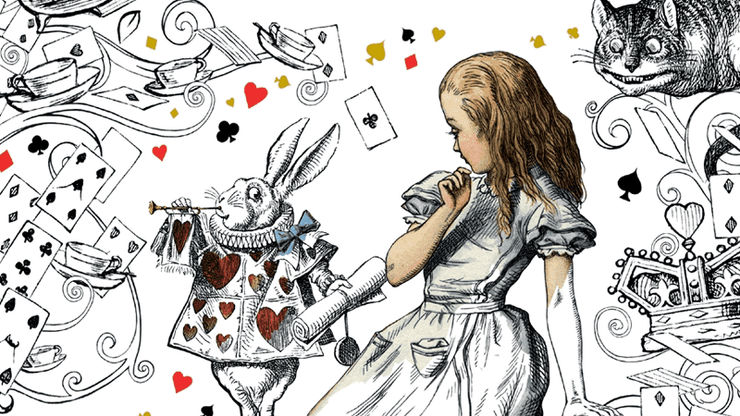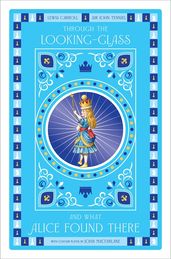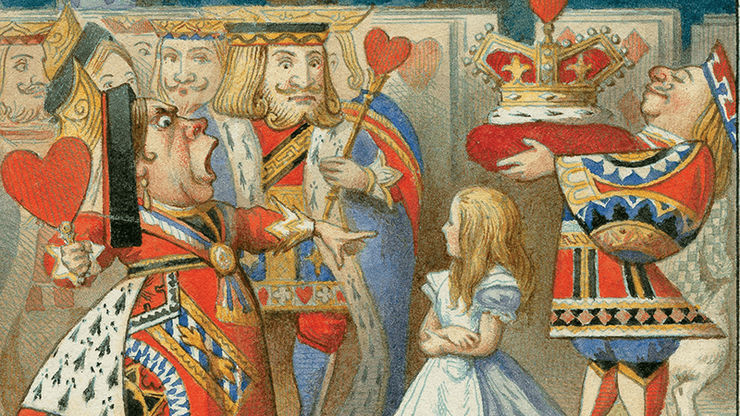Alice’s Adventures in Wonderland: the story of a classic
Discover the story of how Lewis Carroll came to write Alice's Adventures in Wonderland.

The story behind Alice’s Adventures in Wonderland begins with the inventive, playful mind of Charles L. Dodgson (the man behind the pen name Lewis Carroll). A natural storyteller, Dodgson delighted in inventing new stories to entertain his friends. One summer’s afternoon in July 1862 Dodgson rowed up the Thames from Oxford to Godstow with his friend Henry George Liddell and Henry’s eldest daughters, Lorina, Alice and Edith.
It was on this ‘golden afternoon’ that Dodgson first dreamt up the story of Alice and her adventures – inspired by the real little Alice Liddell who asked for a story to keep them amused. The Liddell family loved the tale of Alice’s adventures so much that at the end of the day Alice asked Dodgson to write it down. It would take him two and a half years to complete, but from this afternoon of spontaneous storytelling the Alice in Wonderland we know and love was born.

On 19 October 1863 Dodgson was introduced to the publisher Alexander Macmillan in Oxford by Thomas Combe, director of the Clarendon Press and printer to Oxford University. Macmillan had recently published Charles Kingsley’s children’s novel The Water Babies to much acclaim. Realizing a similar potential in Dodgson’s tale, Macmillan agreed to publish it under Dodgson’s pen name, Lewis Carroll, and on a commission basis: Carroll paid for the printing and marketing, while Macmillan was paid a set commission on sales. This was to be the start of a long and successful publishing relationship between the two of them – Macmillan would go on to publish all of Carroll’s books, as well as many works written under his own name on mathematics, geometry and logic.

After a couple of alternative titles for the story were rejected – Alice Among the Fairies and Alice’s Golden Hour – the book was finally published in 1865 as Alice’s Adventures in Wonderland. The entire print run sold out quickly and Alice’s Adventures in Wonderland became a publishing sensation, adored by children and adults alike.
It was not only Carroll’s wonderful storytelling that captured readers’ imaginations; the illustrations, cleverly incorporated in to the text, brought the story and characters to life and have become part of the book’s cultural phenomenon. They were the work of John Tenniel, a lead cartoonist for the political magazine Punch, whose work Carroll greatly admired. Their collaboration has given us the iconic Alice imagery that remains in our collective consciousness to this day.
To date, Alice’s Adventures in Wonderland has never been out of print and has been translated into at least 176 languages – a story of the timeless joy of pure storytelling, and the mutual passion and vision of author and publisher.
Alice's Adventures in Wonderland
by Lewis Carroll
Gloriously illustrated with the original line drawings by John Tenniel, plates coloured by John Macfarlane, a ribbon marker and a foreword by award-winning children's author Hilary McKay. This beautiful hardback Macmillan Classics edition of Lewis Carroll's Alice's Adventures in Wonderland, which was first published by Macmillan in 1865, is a truly special gift to treasure.
Through the Looking-Glass
by Lewis Carroll
Alice's second adventure takes her through the looking-glass to a place even curiouser than Wonderland. She finds herself caught up in the great looking-glass chess game and sets off to become a queen. It isn't as easy as she expects: at every step she is hindered by nonsense characters who crop up and insist on reciting poems. Some of these poems, such as 'The Walrus and the Carpenter' and 'Jabberwocky', are as famous as the Alice stories themselves.




